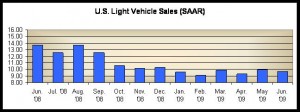Sales of new cars and trucks continued to show, slight, signs of improvement during June. But anticipation of the new federal “cash for clunkers” program that starts in July appears to have slowed sales at the end of the month.
The sales rate dropped slightly from May to under 10 million units and back to about where they were in the bleak January period.
Carmakers said it appears some consumers postponed their purchases to take advantage of the federal cash. The overall economic conditions, particularly tight credit, also continue to weigh on the industry.
Thus, manufacturers continued to post double-digit sales declines right across the board as they have all year. General Motors reported a 33% sales drop, Chrysler said its sales declined 42%, while BMW’s dropped 20%, Mercedes-Benz -23% and Volkswagen sales fell 18%. Even Hyundai, which has gained market share during the first half of 2009, reported its sales dropped 24% in June. Porsche dove 66%. Bentley sagged 43%.
Subaru posted a modest sales increase of 3%, while Kia sales dropped a mere 5% and Audi’s declined 8%. Jim Farley, Ford’s sales and marketing czar, also expressed satisfaction with Ford’s decline of 11%, noting the company was gaining on rivals and it was getting more pricewise for its vehicles.
Meanwhile, Mark LaNeve, GM’s vice president for sales, service and marketing, said that the federal governments new “cash for clunkers” plan could add as many as 250,000 units to the industry’s sales totals in the next few months. “We think there is a lot upside,” he said. “We think this could get the economy through a fragile recovery,” added Mike DiGiovanni, GM general director of market analysis.
LaNeve conceded the automaker’s position is tenuous right now. In addition, GM has now cut is advertising budget by half, making it more difficult to reach customers. Credit is still limited and GMAC does not have money for leasing, LaNeve said. That’s still a head wind for us,” LaNeve added.
“There is not a lot of risk tolerance,” noted DiGiovanni.
Other carmakers professed to see some hope in the numbers.
“We’re seeing signs of strength in our light truck segments with solid gains for Honda’s Odyssey and Pilot models this month,” said John Mendel, executive vice president of sales for American Honda. “American families clearly still have a need for the value and versatility that Honda vehicles have to offer,” he said.
“Volkswagen of America is encouraged by the momentum of our diesel TIDY sales,” said Mark Barnes, Chief Operating Officer, Volkswagen of America. “It appears that U.S. consumers are starting to realize the many benefits of today’s clean diesels — vehicles that attain more than 30% better fuel economy while emitting 25% less greenhouse gas emissions, all without sacrificing driving dynamics,” Barnes added.
Bob Carter, vice president of Toyota Motor Sales, also said the Japanese automaker planned to increase it production by about 65,000 units. However, Carter conceded that that continuing economic difficulties in California have hurt Toyota’s sales totals.
“From a penetration standpoint we get a very high-market share (in California.) The overall market conditions are more challenged there then in other parts of the country,” he said. “The good news is we’re starting to see significant improvements outside of California,” he said. “We’re starting to see a little bit of optimism,” he said.
If optimism among sales executives were sales, then the slump would be over.


